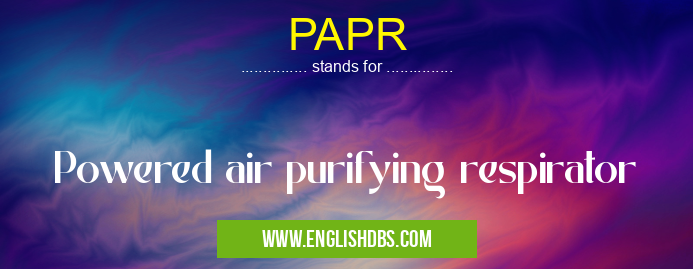What does PAPR mean in NURSING
Powered Air Purifying Respirator (PAPR) is a personal protective equipment (PPE) that provides clean, filtered air to the wearer while protecting against hazardous airborne contaminants. PAPRs are widely used in various industries, healthcare settings, and emergency response situations.

PAPR meaning in Nursing in Medical
PAPR mostly used in an acronym Nursing in Category Medical that means Powered air purifying respirator
Shorthand: PAPR,
Full Form: Powered air purifying respirator
For more information of "Powered air purifying respirator", see the section below.
What does PAPR stand for?
PAPR stands for Powered Air Purifying Respirator.
How does PAPR work?
A PAPR consists of three main components:
- Powered filtering unit: Contains a blower that draws air through a filter, removing contaminants.
- Hood or helmet: Covers the wearer's head and neck, providing a seal against contaminated air.
- Breathing tube: Connects the filtering unit to the hood or helmet, delivering filtered air to the wearer.
Types of PAPRs
PAPR systems can be classified based on the type of hood or helmet used:
- Loose-fitting hooded PAPRs: Provide a loose seal around the wearer's face and neck.
- Tight-fitting hooded PAPRs: Provide a tight seal around the wearer's face, similar to a gas mask.
- Helmet-mounted PAPRs: Offer a wide field of vision and better protection for the wearer's head.
Applications of PAPRs
PAPR systems are used in various settings, including:
- Healthcare: Protecting healthcare workers from airborne infections in isolation rooms, surgery centers, and other high-risk areas.
- Industrial: Protecting workers from hazardous fumes, dust, and other airborne contaminants in manufacturing, construction, and agriculture.
- Emergency response: Providing respiratory protection for firefighters, paramedics, and other first responders responding to hazardous situations.
Advantages of PAPRs
- High level of protection: Provides a continuous supply of filtered air, effectively protecting the wearer against a wide range of airborne contaminants.
- Comfortable to wear: The loose-fitting design allows for better movement and visibility compared to other respiratory protection devices.
- Extended use: PAPR systems can be used for extended periods, making them suitable for situations requiring prolonged protection.
Essential Questions and Answers on Powered air purifying respirator in "MEDICAL»NURSING"
What is a Powered Air Purifying Respirator (PAPR)?
A PAPR is a personal protective equipment (PPE) device that provides a continuous flow of filtered air to the wearer's breathing zone. It consists of a powered air-purifying unit, a breathing tube, and a facepiece or helmet.
How does a PAPR work?
A PAPR draws in ambient air through a filter, which removes contaminants such as dust, fumes, and particles. The filtered air is then blown through the breathing tube into the wearer's facepiece or helmet.
What are the advantages of using a PAPR?
PAPRs offer several advantages over other respiratory protection devices:
- They provide a continuous flow of filtered air, reducing the risk of inhaling contaminants.
- They do not rely on a tight fit to the face, making them more comfortable to wear for extended periods.
- They can be used in environments where other respirators are not effective, such as those with high humidity or oil mist.
What are the disadvantages of using a PAPR?
PAPRs have some disadvantages as well:
- They are more expensive than other respiratory protection devices.
- They can be bulky and heavy, making them uncomfortable to wear for some users.
- They require a source of power, which can limit their use in certain environments.
When should a PAPR be used?
PAPRs are recommended for use in environments where there is a risk of inhaling airborne contaminants, such as:
- Construction sites
- Manufacturing facilities
- Laboratories
- Healthcare settings
- Emergency response situations
How do you maintain a PAPR?
Proper maintenance of a PAPR is crucial for its effective operation. Regular maintenance includes:
- Cleaning and disinfecting the facepiece and breathing tube
- Replacing filters regularly
- Inspecting the unit for damage
- Testing the unit to ensure it is functioning properly
Final Words: Powered Air Purifying Respirators (PAPR) are essential PPE for protecting individuals from hazardous airborne contaminants. Their high level of protection, comfort, and versatility make them valuable respiratory protection devices in various industries, healthcare settings, and emergency response situations.
